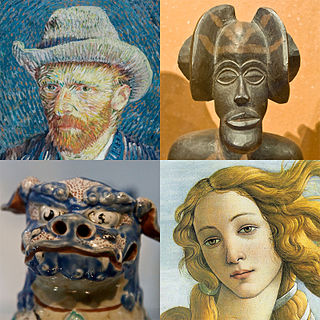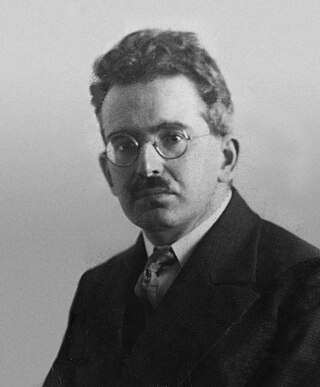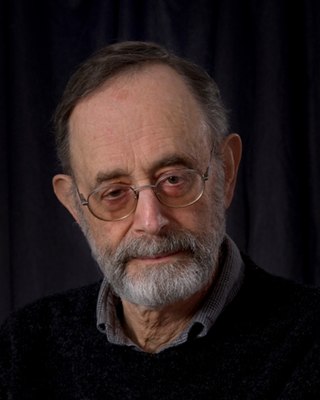
Art is a diverse range of human activity and its resulting product that involves creative or imaginative talent, generally expressive of technical proficiency, beauty, emotional power, or conceptual ideas.

An artist is a person engaged in an activity related to creating art, practicing the arts, or demonstrating an art. The common usage in both everyday speech and academic discourse refers to a practitioner in the visual arts only. However, the term is also often used in the entertainment business, especially in a business context, for musicians and other performers. "Artiste" is a variant used in English in this context, but this use has become rare. The use of the term "artist" to describe writers is valid, but less common, and mostly restricted to contexts such as critics' reviews.
Aesthetics is the branch of philosophy concerned with the nature of beauty and the nature of taste; and functions as the philosophy of art. Aesthetics examines the philosophy of aesthetic value, which is determined by critical judgments of artistic taste; thus, the function of aesthetics is the "critical reflection on art, culture and nature".

In European academic traditions, fine art is made primarily for aesthetics or creative expression, distinguishing it from decorative art or applied art, which also has to serve some practical function, such as pottery or most metalwork. In the aesthetic theories developed in the Italian Renaissance, the highest art was that which allowed the full expression and display of the artist's imagination, unrestricted by any of the practical considerations involved in, say, making and decorating a teapot. It was also considered important that making the artwork did not involve dividing the work between different individuals with specialized skills, as might be necessary with a piece of furniture, for example. Even within the fine arts, there was a hierarchy of genres based on the amount of creative imagination required, with history painting placed higher than still life.

Kitsch is a term applied to art and design that is perceived as naïve imitation, overly eccentric, gratuitous or of banal taste.

Charles Batteux was a French philosopher and writer on aesthetics.

The art world comprises everyone involved in producing, commissioning, presenting, preserving, promoting, chronicling, criticizing, buying and selling fine art. It is recognized that there are many art worlds, defined either by location or alternative definitions of fine art. Some may use the singular art world to refer only to the elite level of globalized fine art. The art world(s) are continually changing in response both to the creativity of those that create art and in response to social change.

Artes mechanicae are a medieval concept of ordered practices or skills, often juxtaposed to the traditional seven liberal arts. Also called "servile" and "vulgar", from antiquity they had been deemed "unbecoming" for a free man, as they minister to basic needs.

Anti-art is a loosely used term applied to an array of concepts and attitudes that reject prior definitions of art and question art in general. Somewhat paradoxically, anti-art tends to conduct this questioning and rejection from the vantage point of art. The term is associated with the Dada movement and is generally accepted as attributable to Marcel Duchamp pre-World War I around 1914, when he began to use found objects as art. It was used to describe revolutionary forms of art. The term was used later by the Conceptual artists of the 1960s to describe the work of those who claimed to have retired altogether from the practice of art, from the production of works which could be sold.

"The Work of Art in the Age of Mechanical Reproduction" (1935), by Walter Benjamin, is an essay of cultural criticism which proposes and explains that mechanical reproduction devalues the aura (uniqueness) of a work of art, and that in the age of mechanical reproduction and the absence of traditional and ritualistic value, the production of art would be inherently based upon the praxis of politics. Written during the Nazi régime (1933–1945) in Germany, in the essay Benjamin presents a theory of art that is "useful for the formulation of revolutionary demands in the politics of art" in a society of mass culture.
This is a history of aesthetics.

Ottoman miniature is a style of illustration found in Ottoman manuscripts, often depicting portraits or historic events. Its unique style was developed from multiple cultural influences, such as the Persian Miniature art, as well as Byzantine and Mongol art. It was a part of the Ottoman book arts, together with illumination (tezhip), calligraphy (hat), marbling paper (ebru), and bookbinding (cilt). The words taswir or nakish were used to define the art of miniature painting in Ottoman Turkish.

Michael Petry is an American multi-media artist and author who lives and works in London. He is director of MOCA, London, and co-founder of the Museum of Installation, also in London. He was formerly the Curator of the Royal Academy Schools Gallery, Guest Curator at the KunstAkademi, Oslo, and Research Fellow at the University of Wolverhampton.

Art historians and philosophers of art have long had classificatory disputes about art regarding whether a particular cultural form or piece of work should be classified as art. Disputes about what does and does not count as art continue to occur today.

Johanna Drucker is an American author, book artist, visual theorist, and cultural critic. Her scholarly writing documents and critiques visual language: letterforms, typography, visual poetry, art, and lately, digital art aesthetics. She is currently the Martin and Bernard Breslauer Professor in the Department of Information Studies at the Graduate School of Education and Information Studies at UCLA. In 2023, she was elected to the American Philosophical Society.

The Indian Arts and Crafts Act of 1990 is a truth-in-advertising law which prohibits misrepresentation in marketing of American Indian or Alaska Native arts and crafts products within the United States. It is illegal to offer or display for sale or sell any art or craft product in a manner that falsely suggests it is Indian produced, an Indian product, or the product of a particular Indian or Indian Tribe or Indian arts and crafts organization, resident within the United States. For a first time violation of the Act, an individual can face civil or criminal penalties up to a $250,000 fine or a five-year prison term, or both. If a business violates the Act, it can face civil penalties or can be prosecuted and fined up to $1,000,000.

Arnold Berleant is an American scholar and author who is active in both philosophy and music.

Folk and traditional arts are rooted in and reflective of the cultural life of a community. They encompass the body of expressive culture associated with the fields of folklore and cultural heritage. Tangible folk art includes historic objects which are crafted and used within a traditional community. Intangible folk arts include forms such as music, dance and narrative structures. Tangible and intangible folk arts were developed to address a need, and are shaped by generational values derived from family and community, through demonstration, conversation and practice.

An art gallery is a room or a building in which visual art is displayed. In Western cultures from the mid-15th century, a gallery was any long, narrow covered passage along a wall, first used in the sense of a place for art in the 1590s. The long gallery in Elizabethan and Jacobean houses served many purposes including the display of art. Historically, art is displayed as evidence of status and wealth, and for religious art as objects of ritual or the depiction of narratives. The first galleries were in the palaces of the aristocracy, or in churches. As art collections grew, buildings became dedicated to art, becoming the first art museums.
Larry E. Shiner is an American philosopher and Professor Emeritus of Philosophy at the University of Illinois at Springfield. Shiner is known for his works on philosophy of art.

















